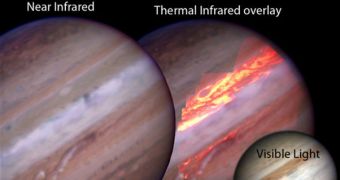Astronomers recently conducted a series of studies meant to provide additional insights into the nature of the Southern Equatorial Belt on Jupiter. The formation disappeared a year ago, and is currently making itself visible again.
Planetary scientists are very interested in learning why the atmospheric structure is behaving in this manner. The process repeats itself every few decades, which further demonstrates that some sort of unknown process is governing it.
The fact that the SEB had disappeared was first observed back in spring 2010, when Jupiter came out from beyond the Sun. At that time, astronomers were only able to observe one of its two stripes.
Experts in the field have been trying to analyze the phenomenon for many years, but thus far their efforts of understanding what's going on have failed, Space reports.
In the new work, scientists sued the Hawaii-based Keck II telescope to look at the gas giant in high resolution. The team was able to derive a series of new data from the observations, which apparently indicate that the upper atmosphere was not the only factor involved in the disappearance act.
“The whole fade and revival of the Southern Equatorial Belt is a bunch of changes in the clouds. We're trying to figure out what causes this process and how the changes are related,” says Mike Wong.
The researcher holds an appointment at the University of California in Berkeley (UCB), and is a member of the team that carried out the study. He and his group used the Keck II telescope because of its advanced adaptive optics system.
This tool allows astronomers to compensate for the interferences that our planet's atmosphere creates in observations carried out from Earth's surface. In effect, experts can see the sky as if our planet had no atmosphere.
At this point, a theory explaining the disappearance of the SEB is that large concentrations of ammonia form clouds on top of the feature under some very precise conditions. Experts say that the clouds largely develop when winds stop sweeping the region.
This cycle lasts for 2 to 3 years, during which time white, icy clouds will cover the SEB entirely. After that time, the winds will return to sweep the clouds away, and make the SEB visible again.
Based on this idea, it's estimated that the gas giant will revert to its more familiar appearance within a few months. Astronomers will continue to monitor the equatorial belts on Jupiter, in hopes that this will give them more insight into the planet's inner workings.

 14 DAY TRIAL //
14 DAY TRIAL //